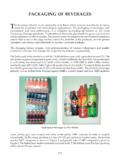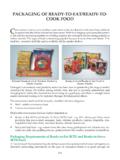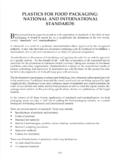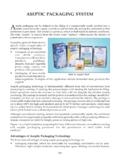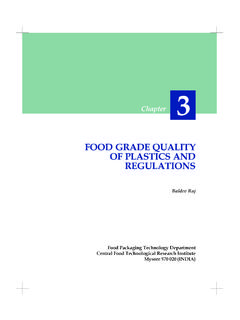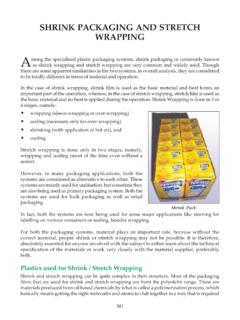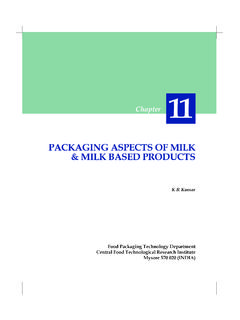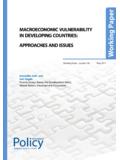Transcription of EVOLUTION OF PACKAGING: TREND AND GROWTH OF …
1 EVOLUTION OF packaging : TREND AND GROWTH OF THE PLASTIC. INDUSTRY. E ver since ancient man felt the need for storing food for the next day's consumption, technology of food packaging in its primitive form emerged. In earlier times, ancient man was using plant leaves to cover the food, which he could not consume, and perhaps that was the beginning of food packaging . As he gathered experience with vulnerability of such protection, the concept was innovated with the formation of a container made from plant leaves using tiny needles of a tree stem. With the progress of civilisation, the concept of protecting food products was developed more and more in response to increasing needs. Traditional Packages (Bamboo Baskets, Wooden Containers and Jute Sacks) for packaging of Fruits and Vegetables The concept of traditional packaging itself is changing with times. Dictionary meaning of traditional is conventional, time honoured, routine or historic.
2 If we ask a senior citizen about traditional packaging , he would cite examples of packages made from plant leaves, bamboo baskets, ceramic jar or earthen pots and other similar forms made from natural materials. For modern packaging , the senior citizen would give examples of metal containers, glass bottles, etc. However, if we ask the same question to a youngster, perhaps he may give examples of metal cans and glass bottles for traditional packaging and for modern packaging he would cite packages such as laminated cartons, blister packs, flexible bottles, PET bottles, various forms of pouches and other similar packages. With the passage of time the concept of traditional and modern packaging will further change. In today's context, packaging is both a symbol of society's consumption habits and reflection of its progress. The user expects the packaging to have better strength, be easier handled, be lighter, more aesthetic and safer from the point of view of hygiene.
3 In addition to its standard attributes, today's packaging is also expected to contribute to protecting the environment, besides being friendly to human health. Emergence of Plastic Packages For food packaging , metal container has been the choice of the food product manufacturers and for some products even glass bottle has been traditionally used for packaging . 31. Till recently, the quantum of steel production was considered to be an index of industrialisation of a country. Even today, the quantity of steel, cement and similar products produced in a country is taken as an indicator of its Modern Plastic Based Packages for Confectionery industrialisation. With development of science and technology, alternative materials like plastics have emerged either to replace natural and traditional materials with a benefit of cost reduction purpose, to cater to certain applications which were not possible with the traditional materials, as well as for enhancing utility of traditional materials.
4 In the new millenium, use of plastics both in terms of quantity and variety is perhaps the correct index of industrialisation of a country, the status of its economy and the standard of living of its citizens. Development of plastics received an impetus in last 30 years as natural materials such as wood was not available in adequate quantities; man-made materials such as steel, glass were found to be very expensive or could not provide economically viable solutions for packaging of products of mass consumption. A few decades back, scientific tools and technology was not available to measure and predict performance of a traditional or conventional packaging . As a result, tendency of package designer/purchaser was to play safe by using over-designed packages. Stronger packages such as metal containers, glass bottles, etc. were used for quite sometime more due to the anxiety of the product marketer for preserving the Traditional Glass product as long as possible.
5 With the development of technology, Bottles for packaging modern gadgets became available to measure and predict protection of Sauces and preservation offered by a given packaging form. In the modern times, product marketer knows precisely the time period (shelf-life) over which the package is required to preserve the product. With the use of plastics, the marketer is in a position to select the right structure, which can give him the desired protection and preservation capabilities required for Traditional Tinplate Containers for Traditional Tinplate Containers and the product and market packaging of Ghee HDPE Containers for Edible Oils 32. needs. Added to this, consumer became more demanding and was not willing to accept inconveniences of traditional and conventional packaging forms. A typical consumer would expect an easy opening package with the features such as easy opening flip top cap or metering or similar devices for retrieving the product in the required quantity and would not like to use instruments such as scissors, knife, etc.
6 To open the packages. Plastic packages have the versatility to provide such convenient features, which boosted development of plastic packaging . Plastic Packages Options In plastics, there are a variety of materials, which are used for packaging applications. The important plastics, which find large packaging applications are HDPE, PP, PVC, Polyester, Polystyrene, etc. These are used for building the body structure of the packages, while other polymers are often used, in less thickness, as coating to improve the functional properties of basic packaging . Examples of such speciality polymer coatings are Polyvinylidene Chloride (PVDC), Ionomer, Ethylene Vinyl Alcohol (EVOH) and others. These speciality coatings provide specific properties such as high barrier to oxygen, moisture aroma/flavour or it may impart sealability to a package even when its surface is contaminated with product.
7 Sometimes, a speciality polymer coating may also provide a good hot tack resistance over a wider temperature range. In other situations, when rigors of handling and distribution demand higher mechanical strength, plastics can be used to enhance such properties. Thus, the advantage of plastics is in the range of mechanical barrier and other properties it offers and also the feasibility of tailoring a structure required to meet precisely the product protection, preservation and distribution needs. Changing trends in Food Processing and packaging Technology Yoghurt Packed in Traditional Earthern Pot and Injection Moulded Plastic Containers The changing food consumer in India will be one of the most powerful forces for change in the food industry. Increasing incomes, increasing literacy rates, smaller family sizes, women entering the work force, urbanisation and increasing concern about health and hygiene will be motivating consumer changes in attitudes.
8 Figure 1 depicts the markets for basic food 33. Figure 1: Today and Tomorrow TODAY Instant noodles, Pastes and purees, Chocolate and Processed meat, Packaged &. Confectionery, Frozen vegetables, Branded Flour, Cheese, Milk powder, Canned fruit, Rice, Sugar, Milk Potato chips, Jam, Instant soups, Pulses, Spices, Ketchup, Fruit Packaged Edible oil, Meat &. beverages, Cakes & buttermilk and Poultry and Fruits pastries, Instant Yoghurt & Vegetables mixes, Breakfast cereal , Condensed Value- milk, Malted food added Grain Sugar Biscuits Milk Pickles Ultimate Edible oils Indian Milk Meat & Poultry products Premium Fruits, Essentials Indian Snack Vegetables foods, Bread, Eggs Tea, Coffee Basic BASIC FOODS PROCESSED FOODS. TOMORROW. New food products Value- like frozen meals added Ultimate Premium Essentials Basic BASIC FOODS PROCESSED FOODS. and processed food today and in the future, taking into account changing consumer attitudes.
9 In response to the changing trends , the traditional processing and packaging technologies have either been improved or a few new technologies have progressed to match new requirements. 34. Table 2 gives the EVOLUTION that has taken place in processing and packaging of food. TABLE 1. EVOLUTION of Processing and packaging of Food Past Present Future Canning Map/Cap system Biotechnology Pasteurization Aseptic system High pressure processing Freezing Anti microbial Pulsed electric field Dehydration Biosensors/Chemical markers Pulsed light field Robotics, computers Infusion technologies, Irradiation, Microwave These new processes either extend the shelf-life of food product or allow more sophisticated product or different packaging concepts. They also improve the nutritional and sensory properties of the food product during its entire shelf-life. Minimal Processing Technologies for Food Preservation Consumers increasingly demand food, which Aseptic packaging retains the natural flavour, colour and texture and contains fewer additives such as preservatives.
10 In response to these needs, one of the most important recent developments in the food industry has been the development of minimal processing technologies designed to limit the impact of processing on nutritional and sensory quality and to preserve food without the use of synthetic additives. Traditional thermal processing techniques can be both beneficial to food in such areas as preservation and flavour formation but detrimental in damaging other sensory and nutritional properties. Minimisation of undesirable changes can be achieved in a number of ways, whether through more effective process control, the use of High Temperature Short Time (HTST) techniques such as aseptic processing, or newer thermal technologies such as volume heating methods, infrared heating, dielectric methods such as the use of microwaves, and ohmic heating etc. The other alternates to thermal processing, range from irradiation to high pressure processing and the use of pulsed electric fields.
